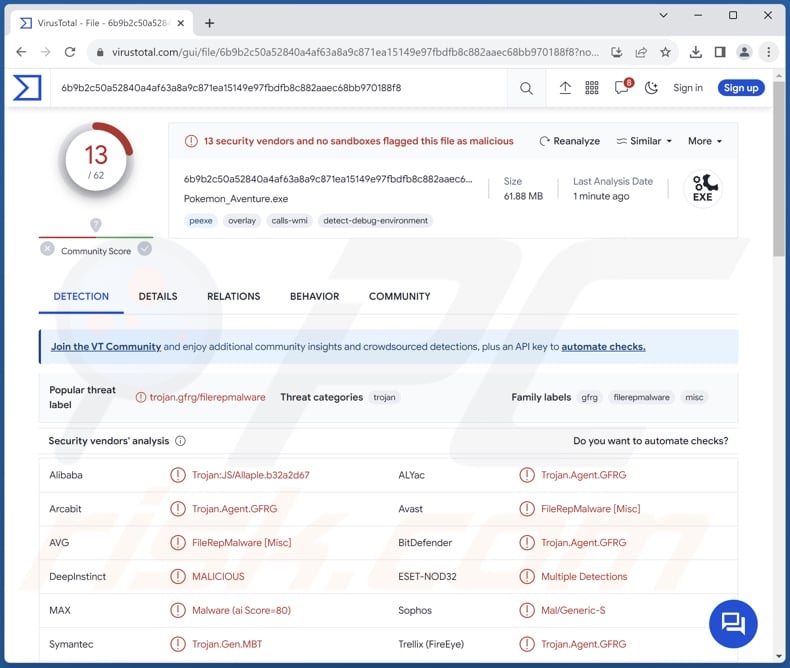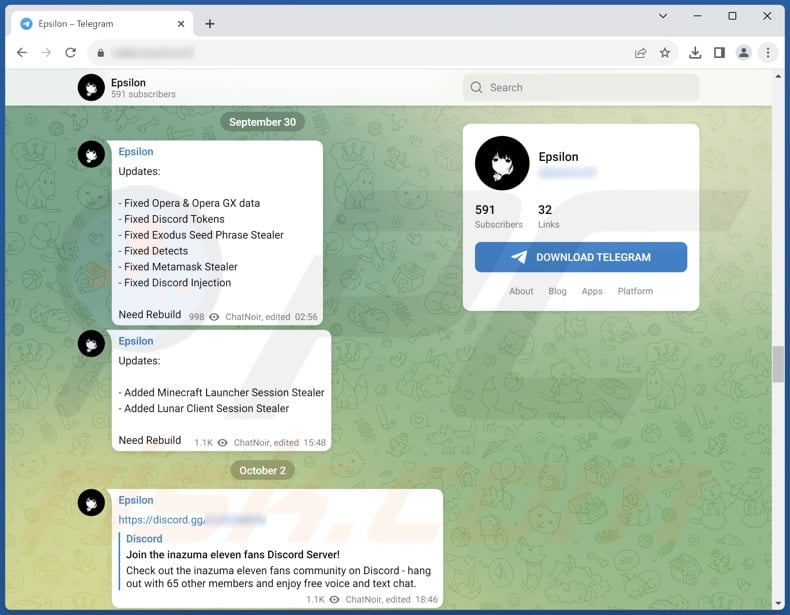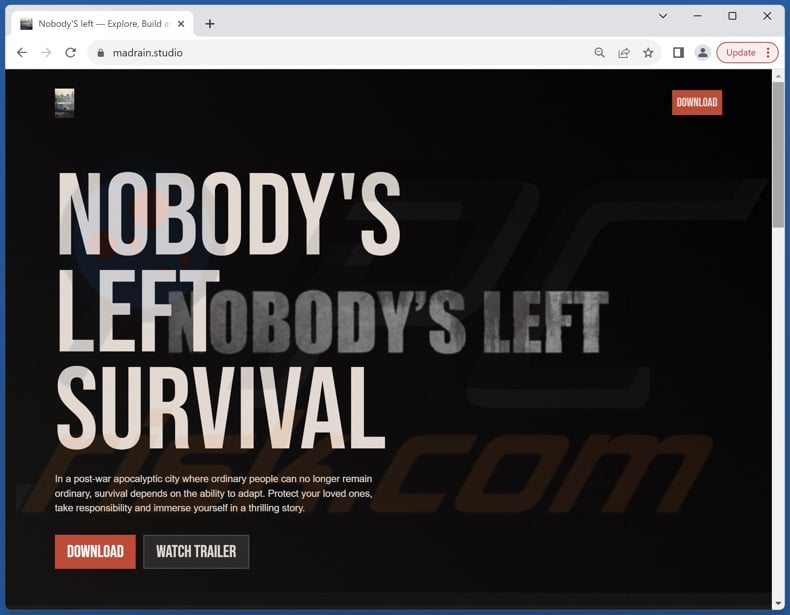How to eliminate the Epsilon stealer-type malware from your operating system
TrojanAlso Known As: Epsilon malware
Get free scan and check if your device is infected.
Remove it nowTo use full-featured product, you have to purchase a license for Combo Cleaner. Seven days free trial available. Combo Cleaner is owned and operated by RCS LT, the parent company of PCRisk.com.
What kind of malware is Epsilon?
Epsilon is the name of a malware designed to steal sensitive information. This stealer targets data from browsers, gaming-related and various other applications, as well as cryptocurrency wallets. Epsilon stealer has been observed being proliferated via campaigns targeting video game players.

Epsilon malware overview
After successfully infiltrating a system, Epsilon starts collecting relevant device data. This stealer can extract and exfiltrate information from browsers. Typically, data of interest includes: browsing and search engine histories, Internet cookies, stored log-in credentials (usernames/passwords), saved credit card numbers, etc.
Epsilon can obtain information associated with messaging platforms. To elaborate, this program can self-inject into Discord, and it also gathers Discord tokens. Among the types of software targeted by Epsilon are applications related to video gaming. For example, this stealer seeks to acquire Minecraft sessions.
Additionally, the stealer aims to obtain log-in credentials and other information from cryptocurrency wallets and related software (e.g., MetaMask, etc.).
It must be mentioned that malware developers commonly improve upon their software; therefore, potential future versions of Epsilon could have a broader target list and additional/different capabilities.
To summarize, the presence of malware like Epsilon on devices may lead to severe privacy issues, financial losses, and identity theft.
| Name | Epsilon malware |
| Threat Type | Trojan, stealer, password-stealing virus, banking malware, spyware. |
| Detection Names | Avast (FileRepMalware [Misc]), Combo Cleaner (Trojan.Agent.GFRG), ESET-NOD32 (Multiple Detections), Sophos (Mal/Generic-S), Symantec (Trojan.Gen.MBT), Full List Of Detections (VirusTotal) |
| Symptoms | Trojans are designed to stealthily infiltrate the victim's computer and remain silent, and thus no particular symptoms are clearly visible on an infected machine. |
| Distribution methods | Infected email attachments, malicious online advertisements, social engineering, software 'cracks'. |
| Damage | Stolen passwords and banking information, identity theft, the victim's computer added to a botnet. |
| Malware Removal (Windows) |
To eliminate possible malware infections, scan your computer with legitimate antivirus software. Our security researchers recommend using Combo Cleaner. Download Combo CleanerTo use full-featured product, you have to purchase a license for Combo Cleaner. 7 days free trial available. Combo Cleaner is owned and operated by RCS LT, the parent company of PCRisk.com. |
Stealer-type malware examples
Serpent, Laze, TrapStealer, Poverty, and Lumar are just some examples of stealers we have researched recently. Information-stealing malware is incredibly prevalent. It can seek specific details or a vast array of data. This malicious software is not necessarily limited to its classification, meaning that it can have other functionalities unassociated with data theft.
It must be stressed that regardless of how malware operates – its presence on a system endangers device integrity and user safety. Hence, all threats must be removed immediately upon detection.
How did Epsilon infiltrate my computer?
Epsilon is offered for sale by its developers on Telegram and Discord. Therefore, how this stealer is proliferated depends on the cyber criminals using it.
Several Epsilon-spreading campaigns were noted; these operations targeted the gaming community. The malicious files carrying this malware were obtained by victims from fake sites offering game downloads (e.g., Pokemon, Nobody's Left, etc.).
These webpages were promoted through spam, posted publicly and sent privately via Discord. The accounts posting this content were typically ones that have been compromised, as the promotion is far more successful if it is believed to be coming from reputable sources.
The initially downloaded files were observed in the following formats – executables, password-protected RAR archives, and ZIP archives. In some instances, after the infectious file was launched, the victims were presented with decoy dialogue boxes requesting them to provide beta tester keys.
It is pertinent to mention that other formats, sites, and lures are not unlikely to be used in Epsilon's proliferation. Gaming-centered bait can include free video game downloads, "cracked" versions, "hacks" and "cheats", mods, in-game currencies and other assets, etc.
Malicious files come in various formats; aside from executables and archives, other common types include JavaScript and documents (e.g., Microsoft Office, Microsoft OneNote, PDF, etc.). Phishing and social engineering techniques are often used in malware distribution.
Widespread proliferation methods include: malicious attachments or links in spam mail (e.g., emails, PMs/DMs, SMSes, etc.), malvertising, online scams, drive-by (stealthy/deceptive) downloads, illegal software activation ("cracking") tools, and fake updates.
Some malicious programs can even self-spread through local networks and removable storage devices (e.g., USB flash drives, external hard drives, etc.).
How to avoid installation of malware?
We highly recommend treating incoming emails and other messages with caution. Attachments or links found in suspicious/irrelevant mail must not be opened, as they can be virulent. It is essential to be careful while browsing since fake and malicious online content usually appears genuine and innocuous.
Additionally, all downloads must be performed from official and verified channels. Another recommendation is to activate and update programs using legitimate functions/tools, as those obtained from third-parties can contain malware.
We must emphasize the importance of having a dependable anti-virus installed and kept updated. This software must be used to run regular system scans and to remove threats and issues. If you believe that your computer is already infected, we recommend running a scan with Combo Cleaner Antivirus for Windows to automatically eliminate infiltrated malware.
Screenshot of Epsilon stealer promoted on Telegram:

Screenshot of a fake Pokemon game website used to spread Epsilon stealer:

Screenshot of a fake Nobody's Left game download website used to spread Epsilon stealer:

Instant automatic malware removal:
Manual threat removal might be a lengthy and complicated process that requires advanced IT skills. Combo Cleaner is a professional automatic malware removal tool that is recommended to get rid of malware. Download it by clicking the button below:
DOWNLOAD Combo CleanerBy downloading any software listed on this website you agree to our Privacy Policy and Terms of Use. To use full-featured product, you have to purchase a license for Combo Cleaner. 7 days free trial available. Combo Cleaner is owned and operated by RCS LT, the parent company of PCRisk.com.
Quick menu:
- What is Epsilon?
- STEP 1. Manual removal of Epsilon malware.
- STEP 2. Check if your computer is clean.
How to remove malware manually?
Manual malware removal is a complicated task - usually it is best to allow antivirus or anti-malware programs to do this automatically. To remove this malware we recommend using Combo Cleaner Antivirus for Windows.
If you wish to remove malware manually, the first step is to identify the name of the malware that you are trying to remove. Here is an example of a suspicious program running on a user's computer:

If you checked the list of programs running on your computer, for example, using task manager, and identified a program that looks suspicious, you should continue with these steps:
 Download a program called Autoruns. This program shows auto-start applications, Registry, and file system locations:
Download a program called Autoruns. This program shows auto-start applications, Registry, and file system locations:

 Restart your computer into Safe Mode:
Restart your computer into Safe Mode:
Windows XP and Windows 7 users: Start your computer in Safe Mode. Click Start, click Shut Down, click Restart, click OK. During your computer start process, press the F8 key on your keyboard multiple times until you see the Windows Advanced Option menu, and then select Safe Mode with Networking from the list.

Video showing how to start Windows 7 in "Safe Mode with Networking":
Windows 8 users: Start Windows 8 is Safe Mode with Networking - Go to Windows 8 Start Screen, type Advanced, in the search results select Settings. Click Advanced startup options, in the opened "General PC Settings" window, select Advanced startup.
Click the "Restart now" button. Your computer will now restart into the "Advanced Startup options menu". Click the "Troubleshoot" button, and then click the "Advanced options" button. In the advanced option screen, click "Startup settings".
Click the "Restart" button. Your PC will restart into the Startup Settings screen. Press F5 to boot in Safe Mode with Networking.

Video showing how to start Windows 8 in "Safe Mode with Networking":
Windows 10 users: Click the Windows logo and select the Power icon. In the opened menu click "Restart" while holding "Shift" button on your keyboard. In the "choose an option" window click on the "Troubleshoot", next select "Advanced options".
In the advanced options menu select "Startup Settings" and click on the "Restart" button. In the following window you should click the "F5" button on your keyboard. This will restart your operating system in safe mode with networking.

Video showing how to start Windows 10 in "Safe Mode with Networking":
 Extract the downloaded archive and run the Autoruns.exe file.
Extract the downloaded archive and run the Autoruns.exe file.

 In the Autoruns application, click "Options" at the top and uncheck "Hide Empty Locations" and "Hide Windows Entries" options. After this procedure, click the "Refresh" icon.
In the Autoruns application, click "Options" at the top and uncheck "Hide Empty Locations" and "Hide Windows Entries" options. After this procedure, click the "Refresh" icon.

 Check the list provided by the Autoruns application and locate the malware file that you want to eliminate.
Check the list provided by the Autoruns application and locate the malware file that you want to eliminate.
You should write down its full path and name. Note that some malware hides process names under legitimate Windows process names. At this stage, it is very important to avoid removing system files. After you locate the suspicious program you wish to remove, right click your mouse over its name and choose "Delete".

After removing the malware through the Autoruns application (this ensures that the malware will not run automatically on the next system startup), you should search for the malware name on your computer. Be sure to enable hidden files and folders before proceeding. If you find the filename of the malware, be sure to remove it.

Reboot your computer in normal mode. Following these steps should remove any malware from your computer. Note that manual threat removal requires advanced computer skills. If you do not have these skills, leave malware removal to antivirus and anti-malware programs.
These steps might not work with advanced malware infections. As always it is best to prevent infection than try to remove malware later. To keep your computer safe, install the latest operating system updates and use antivirus software. To be sure your computer is free of malware infections, we recommend scanning it with Combo Cleaner Antivirus for Windows.
Frequently Asked Questions (FAQ)
My computer is infected with Epsilon malware, should I format my storage device to get rid of it?
Malware removal rarely requires formatting.
What are the biggest issues that Epsilon malware can cause?
The threats associated with an infection depend on the malicious program's capabilities and the cyber criminals' goals. Epsilon is designed to steal a variety of vulnerable information. Generally, infections of this kind can lead to serious privacy issues, financial losses, and identity theft.
What is the purpose of Epsilon malware?
Most malicious programs are used to generate revenue. However, cyber criminals can also use malware to amuse themselves, realize personal grudges, disrupt processes (e.g., sites, services, companies, etc.), and even launch politically/geopolitically motivated attacks.
How did Epsilon malware infiltrate my computer?
Epsilon has been noted being spread through fake video game download websites, which were promoted through Discord. However, other disguises and distribution techniques are not unlikely.
The most commonly used methods include: drive-by downloads, online scams, spam emails/messages, malvertising, dubious download channels (e.g., freeware and free file-hosting sites, P2P sharing networks, etc.), illegal software activation tools ("cracks"), and fake updates. Furthermore, some malicious programs can self-proliferate through local networks and removable storage devices.
Will Combo Cleaner protect me from malware?
Yes, Combo Cleaner is designed to detect and remove all manner of threats. It is capable of eliminating nearly all known malware infections. Note that since sophisticated malicious programs typically hide deep within systems – running a complete system scan is paramount.
Share:

Tomas Meskauskas
Expert security researcher, professional malware analyst
I am passionate about computer security and technology. I have an experience of over 10 years working in various companies related to computer technical issue solving and Internet security. I have been working as an author and editor for pcrisk.com since 2010. Follow me on Twitter and LinkedIn to stay informed about the latest online security threats.
PCrisk security portal is brought by a company RCS LT.
Joined forces of security researchers help educate computer users about the latest online security threats. More information about the company RCS LT.
Our malware removal guides are free. However, if you want to support us you can send us a donation.
DonatePCrisk security portal is brought by a company RCS LT.
Joined forces of security researchers help educate computer users about the latest online security threats. More information about the company RCS LT.
Our malware removal guides are free. However, if you want to support us you can send us a donation.
Donate
▼ Show Discussion